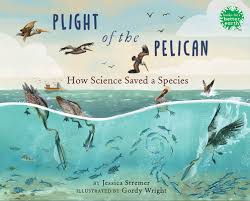Environmental Protection Agency
4 Reviews
(2)
K-3
Books for a Better Earth series.
Illustrated by
Gordy Wright.
The partnership between Stremer's expressive and suspenseful text and Wright's evocative hand-painted gouache, ink, and acrylic illustrations (see [cf2[Great Carrier Reef, rev. 7/23) gives readers an exceptionally clear picture of the discovery and correction of one historical threat to wildlife: the use of DDT on crops. The text on the opening spread is positioned like a projectile moving across the page in concert with a brown pelican pod flying together, which plunges as the birds dive for fish. Readers then discover a problem that scientists noticed in the 1950s: fewer and fewer pelicans being born. The text asks: why? Scientists find that the birds' eggshells have become so fragile they cannot support the parents' weight in the nest. Again, the same question: why? And again, scientists search to find the answer, eventually theorizing that DDT contaminates the food chain, leading to weakened shells. They test this hypothesis, and even though they find strong evidence of the link, these findings are rejected by farmers, the companies that produce DDT, and the government. But public protest drowns out these voices, and the use of DDT is finally eliminated. The book concludes with other concerns that threaten wildlife today. Extensive back matter offers further detail (including spelling out Rachel Carson's role in sounding the alarm about DDT), additional brown pelican facts, a glossary, a bibliography, and an index.
Reviewer: Betty Carter
| Horn Book Magazine Issue:
March, 2025
(2)
K-3
Illustrated by
Alex Boersma.
Levy and Boersma's gentle and accessible introduction to climate change centers on carbon and its ubiquitous presence in Earth's living and nonliving systems. Brief definitions of key chemistry terms and concepts precede the title page, and statements in the first few pages lay out the crisis we face with global warming: "After hundreds of years and billions of people burning fuels, there's too much carbon in the air!" The remainder of the book is hopeful, showing how kelp forests, mangroves, and even dirt can "soak up" the excess carbon. Boersma's illustrations represent carbon as delicate white dots swirling in the air over sunny city scenes and landscapes or crowded into the clouds of darker emissions from power plants. The book ends with a call to action: "For the Earth to keep helping us, we must help the Earth." The meaningful solutions presented include alternative energies, public transportation, and scientific innovation. Additional information about global warming and things readers can do to help are included in the back matter.
Reviewer: Danielle J. Ford
| Horn Book Magazine Issue:
January, 2024
 Wittenstein, Barry
Wittenstein, Barry
The Day the River Caught Fire: How the Cuyahoga River Exploded and Ignited the Earth Day Movement
(2)
K-3
Illustrated by
Jessie Hartland.
What kind of spark is needed to ignite a global movement? In the case of the Earth Day Movement, it was quite literally sparks from a railcar landing in the heavily polluted and quite flammable Cuyahoga River in Cleveland, Ohio. "KABOOM!" While not the first time the river had caught fire, this time, as Wittenstein's enlightening text shows, residents had had enough. Spurred on by the activism of the 1960s, they demanded action to clean up the river, and by extension the planet. While young readers may take for granted the concept of environmentalism, the book does an excellent job depicting the nascent moments of the movement that led to the first Earth Day celebration, the establishment of the Environmental Protection Agency, and legislation such as the Clean Water Act. Hartland's playful gouache paintings shine, reflecting a child's perspective on the events and conveying their emotional significance and ramifications. Back matter consists of a detailed author's note providing additional historical details; a timeline of the environmental movement; a bibliography; and a list of resources where readers can learn more about the Cuyahoga River Fire of 1969, Earth Day, and more about protecting our planet.
Reviewer: Eric Carpenter
| Horn Book Magazine Issue:
May, 2023
(4)
4-6
Agents of Government series.
This book presents an abbreviated history of the EPA, established in 1970. Wimmer chronicles the agency's evolution from a series of legislative bills to its broad oversight and enforcement powers today. Emphasis is placed on safe environmental practices and sustainability of renewable energy for future generations. Though the small-size type may be off-putting, the accessible text is enhanced by large photographs. Websites. Bib., glos., ind.
Reviewer: Luther B. Clegg
4 reviews
We are currently offering this content for free. Sign up now to activate your personal profile, where you can save articles for future viewing.






